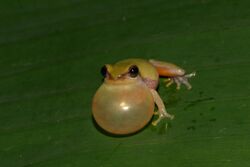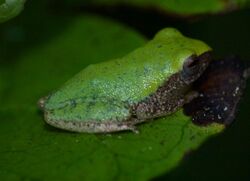Biology:Raorchestes akroparallagi
| Variable bush frog | |
|---|---|

| |
| Scientific classification | |
| Domain: | Eukaryota |
| Kingdom: | Animalia |
| Phylum: | Chordata |
| Class: | Amphibia |
| Order: | Anura |
| Family: | Rhacophoridae |
| Genus: | Raorchestes |
| Species: | R. akroparallagi
|
| Binomial name | |
| Raorchestes akroparallagi (Biju and Bossuyt, 2009)
| |
Raorchestes akroparallagi (sometimes known as the variable bush frog) is a species of frogs in the family Rhacophoridae.
It is endemic to the Western Ghats, India , where it is known from the states of Kerala and Tamil Nadu. Before its description in 2009, it was confused with Raorchestes femoralis and Raorchestes glandulosus.[2]
Description
Male Raorchestes akroparallagi are small, 19–22.5 mm (0.75–0.89 in) in snout-vent length, whereas females are larger, 26–27 mm (1.0–1.1 in) long. It is one of predominantly green Raorchestes. However, the colouration of its dorsum (back) is highly variable even within a single location, from almost uniformly green to various colours and markings. Indeed, its specific name, akroparallagi, is derived from Greek words akro, meaning 'extreme' and parallagi, meaning 'variation'.[3]
Reproduction
Raorchestes akroparallagi has direct development, with all growth inside the egg and no free-swimming tadpole stage. Males attract females with their calls. Mating takes place during the night. A pair in amplexus may move around before settling on a leaf and starting to lay eggs on its upper side. Egg laying takes hours and results in a clutch of 20–41 eggs. Eggs are white, about 4.4 mm (0.17 in) in diameter, and hatch after four weeks as fully developed froglets. There is no parental care.[4]
Habitat
Raorchestes akroparallagi is relatively widespread and occurs in a wide range of habitats and can live in disturbed habitats. It is found in evergreen forests to plantations near forest fringes and in roadside vegetation. It has been observed between 450 and 1000 meters above sea level.[5][6][1][3] IUCN does not considered it threatened.[1]
References
- ↑ 1.0 1.1 1.2 IUCN SSC Amphibian Specialist Group (2012). "Raorchestes akroparallagi". IUCN Red List of Threatened Species 2012: e.T186158A1810433. doi:10.2305/IUCN.UK.2012-1.RLTS.T186158A1810433.en. https://www.iucnredlist.org/species/186158/1810433. Retrieved 19 November 2021.
- ↑ Frost, Darrel R. (2013). "Raorchestes akroparallagi (Biju and Bossuyt, 2009)". Amphibian Species of the World 5.6, an Online Reference. American Museum of Natural History. http://research.amnh.org/vz/herpetology/amphibia/?action=names&taxon=Raorchestes+akroparallagi.
- ↑ 3.0 3.1 Cite error: Invalid
<ref>tag; no text was provided for refs namedBijuBossuyt - ↑ Biju, S. D. (2003). "Reproductive mode in the shrub frog Philautus glandulosus (Jerdon, 1853) (Anura: Rhacophoridae)". Current Science 84 (3): 283–284. http://www.iisc.ernet.in/currsci/feb102003/283.pdf. (N.b. This article predates the description of Raorchestes akroparallagi, and at that point the species was confused with Raorchestes glandulosus — see Biju & Bossuyt, 2009, p. 392.)
- ↑ Frost, Darrel R.. "Raorchestes jayarami (Biju and Bossuyt, 2009)". American Museum of Natural History, New York. https://amphibiansoftheworld.amnh.org/Amphibia/Anura/Rhacophoridae/Rhacophorinae/Raorchestes/Raorchestes-akroparallagi.
- ↑ "Raorchestes akroparallagi (Biju and Bossuyt, 2009)". University of California, Berkeley. https://amphibiaweb.org/species/7254.
External links
Wikidata ☰ Q3419063 entry
 |



